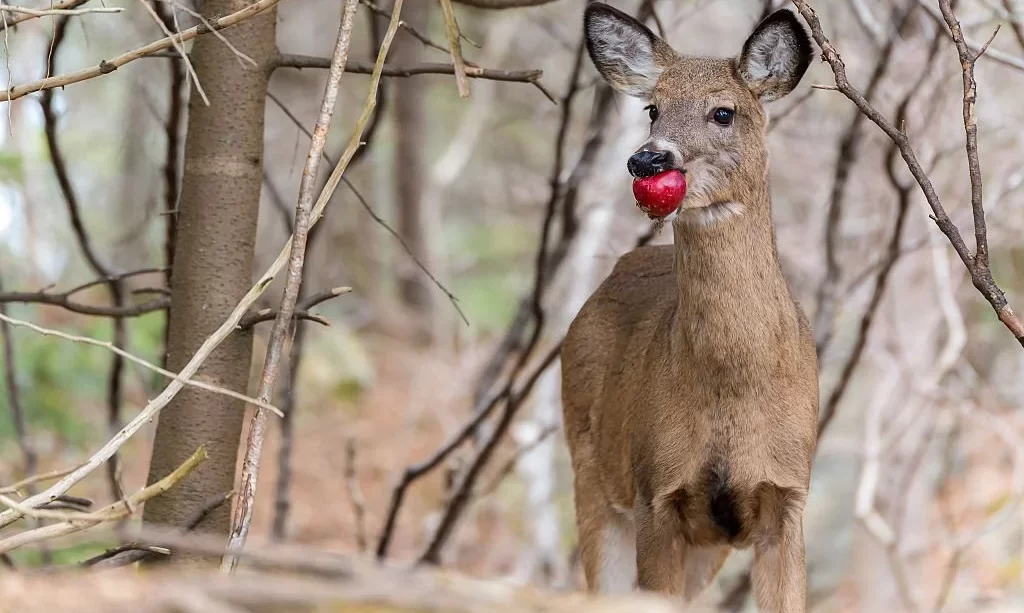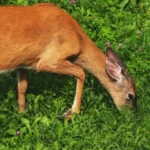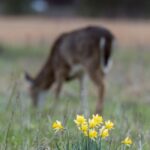Crabapple trees, with their delicate blossoms and vibrant fruits, have long been a cherished presence in landscapes and gardens. These ornamental trees, known for their stunning display of colorful flowers and miniature apples, bring a touch of natural beauty to outdoor spaces. As homeowners and gardeners take pride in nurturing these trees, a curious question often arises: Do deer eat crabapples? In this exploration, we embark on a journey to unravel the relationship between deer and crabapple trees. We will delve into the enduring allure of crabapple trees, understand the dietary habits of deer, and seek to determine whether these gentle grazers are drawn to the tempting bounty of crabapples.
- 2 Dolgo Crabapple Trees Live Plants From 16 To 24 Inc Height, Red Crab Apple Plants Live, Cannot To CA
- Beautiful blooms begin in April
- Zones 3 to 9
- Years to Bear 2 to 4 Yrs
- Mature Plant Size 15 to 25 ft
The Appeal of Crabapple Trees
Crabapple trees have secured their place as beloved ornamental specimens in gardens and landscapes. Their popularity stems from their remarkable aesthetic qualities and horticultural diversity. With an extensive range of cultivars featuring an array of flower colors, leaf shapes, and fruit sizes, crabapples offer a spectrum of options for homeowners and horticultural enthusiasts.
These trees play a vital role in enhancing the visual appeal of outdoor spaces, particularly during the spring bloom when their blossoms burst forth in shades of pink, white, and red. Beyond their ornamental value, crabapple trees serve as essential pollinator-friendly trees, attracting bees and butterflies to gardens.
Crabapples have a unique charm that extends beyond their showy blossoms. The miniature apples they bear, though not typically consumed by humans, add an element of whimsy to the landscape. Their small, colorful fruit often remains on the tree well into the fall, providing visual interest and perhaps a culinary curiosity for wildlife, including deer.
Deer Behavior and Feeding Habits
Understanding the feeding habits of deer is essential when considering their interaction with crabapple trees. Deer are herbivores and graze on a variety of plant materials, including leaves, twigs, and, on occasion, fruits. Their dietary preferences can vary based on factors such as the availability of food sources and seasonal changes.
Deer are known to be opportunistic feeders, adapting their diet to the resources around them. While their primary forage consists of native plants like grasses and shrubs, they may also turn to other available food sources when necessary. This adaptability can lead them to explore fruit-bearing trees like crabapples, especially during periods of food scarcity or when alternative options are limited.
As we delve further into the interaction between deer and crabapples, we will explore whether these graceful creatures indeed find crabapples irresistible and whether their presence in gardens is a cause for concern among gardeners and homeowners.
Do Deer Eat Crabapples?
The question of whether deer consume crabapples is met with a nuanced answer. While deer are known to be occasional consumers of crabapples, it’s essential to consider several factors that influence their dietary choices. Studies and observations have provided insights into this interaction between deer and crabapple trees.
Deer may indeed eat crabapples, especially when the fruit is ripe and readily available. However, their preference for crabapples can vary depending on several factors, including the local deer population, the abundance of other natural food sources, and seasonal changes. In regions where alternative forage is limited, deer may be more inclined to browse on crabapples. Still, it’s worth noting that deer typically graze on the tender foliage and twigs of plants more than the fruit itself.
Factors Influencing Deer Feeding
Several factors come into play when considering deer’s choice to feed on crabapples. One of the primary influencers is the availability of natural food sources. Deer are selective grazers and will opt for native plants, shrubs, and grasses when these are abundant and nutritionally sufficient. However, when food is scarce or less nutritious due to seasonal changes, deer may turn to other options, such as fruit-bearing trees like crabapples.
Seasonal variations also impact deer feeding habits. During the winter months, when green vegetation becomes scarce, deer may be more inclined to browse on woody plants and fruits. In contrast, the spring and summer abundance of native forage may reduce their interest in crabapples.
Local deer populations can further shape the dynamics of this interaction. In areas with a high deer density and limited natural food sources, crabapple trees may experience more frequent browsing. Conversely, in regions with ample native vegetation, deer may have less interest in crabapples.
As we navigate the complexities of deer behavior and their dietary choices, it becomes evident that while deer may occasionally enjoy the offerings of crabapple trees, their interaction with these ornamental trees depends on a delicate balance of ecological factors. Gardeners and homeowners should consider these dynamics when managing their landscapes and protecting their beloved crabapple trees from potential browsing.
Protecting Crabapples from Deer
Gardeners and homeowners who wish to safeguard their cherished crabapple trees from potential deer browsing have several strategies at their disposal. While deer may occasionally nibble on crabapples, there are effective measures to deter them and preserve the beauty of these ornamental trees.
- Fencing: Installing a deer-proof fence around your garden or individual crabapple trees can be one of the most reliable methods of protection. Ensure the fence is of adequate height and design to prevent deer from accessing the trees. Electric fences can also be an effective deterrent.
- Deer-Resistant Plants: Surround your crabapple trees with plants that are known to be less appealing to deer. These can act as a buffer zone, discouraging deer from approaching the trees. Deer-resistant plants include lavender, yarrow, and ornamental grasses.
- Repellents: Various deer repellent sprays and granules are available on the market. These products emit odors or tastes that are unpleasant to deer, discouraging them from browsing on your crabapple trees. Regular reapplication may be necessary, especially after rain.
- Netting: Covering crabapple trees with netting during the fruiting season can physically prevent deer from reaching the fruit. Be sure to secure the netting properly to avoid entanglement.
- Scare Tactics: Using scare tactics like motion-activated lights, radios, or scarecrows can startle deer and make them hesitant to approach your garden.
- Tough durable deer netting; Protects landscape and crops from deer and other animals
- Economical, lightweight deer protection; Black UV-resistant deer netting
- Reusable mesh deer fence; Stops deer and other animals from eating shrubs, berries, and vegetables
- Easy to use roll of deer fence netting; Attaches easily to posts and trees
- Do it yourself deer netting for protecting trees, shrubs, orchards and crops
Conclusion
In conclusion, the question of whether deer eat crabapples leads us into the fascinating world of ecological interactions between wildlife and horticulture. While deer may occasionally nibble on crabapple trees, their dietary choices are influenced by various factors, including food availability, seasonal variations, and local deer populations.
For gardeners and homeowners, the allure of crabapple trees lies not only in their visual beauty but also in their potential to coexist with local wildlife. By understanding the dynamics of deer behavior and employing protective measures like fencing, deer-resistant plants, repellents, and netting, gardeners can strike a balance that allows these magnificent trees to thrive while minimizing the risk of damage.
Crabapple trees remain a valuable asset in horticulture, offering a symphony of blossoms and fruit that enriches the garden landscape. By taking proactive steps to protect them, we can continue to enjoy the aesthetic wonders of crabapples while respecting the presence of deer in our natural surroundings.






